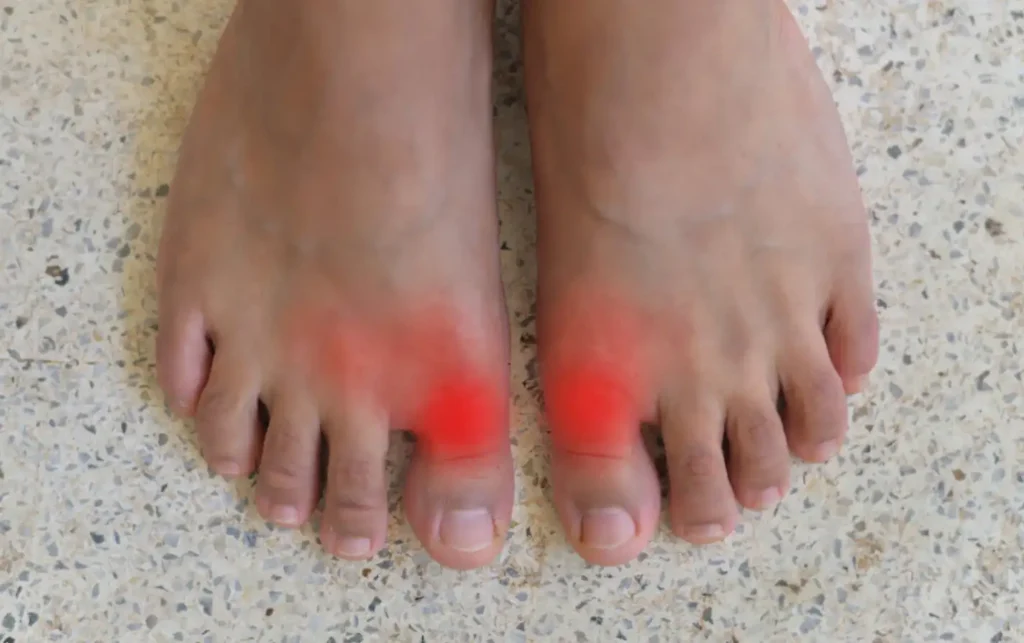The metatarsophalangeal (MTP) joint connects your big toe to your foot. It’s key for supporting your body weight and allowing toe movement. Pain in this joint can come from arthritis, injuries, or deformities like bunions. big toe joint pain
Symptoms include pain, swelling, and limited mobility. These can make walking uncomfortable.
Understanding big toe joint pain and its treatments can help you find relief. You can try lifestyle changes, medication, or surgery for severe cases. There are many ways to tackle the problem and improve your mobility.
In this guide, we’ll dive into the big toe joint’s anatomy, common pain causes, and how to manage it. Knowing about big toe joint pain helps you take steps towards a healthier, more comfortable life.
Understanding the Anatomy of Your Big Toe Joint
The big toe, or hallux, is key to your foot’s function. The joint at its base, the metatarsophalangeal (MTP) joint, is vital for foot movement. Knowing about this joint helps you see its importance and spot potential problems.
The Role of the Metatarsophalangeal (MTP) Joint
The MTP joint connects the first long bone of your foot to the first bone of your big toe. It lets your big toe bend and straighten. This is important for walking, running, and pushing off during movement.
This joint bears a lot of your body weight. It’s also a key point for pushing off, making it essential for balance and movement.
How Your Big Toe Supports Movement
The big toe’s movement and flexibility are crucial for walking and balance. The MTP joint’s ability to bend helps push you forward. Any problems with this joint can affect your mobility and balance.
Understanding the big toe joint’s anatomy helps in diagnosing and managing issues. It ensures the joint works right.
Common Symptoms of Joint Pain in the Big Toe

If you’re feeling pain in your big toe joint, you’re not alone. This issue can show up in many ways, like stiffness, swelling, redness, and trouble moving. Walking or wearing tight shoes can make it worse. You might also find it harder to bend your toe.
Big toe pain can start suddenly or slowly over time. Problems like osteoarthritis, rheumatoid arthritis, and hallux rigidus often cause it. These issues lead to inflammation, pain, and less movement in the MTP joint at the big toe’s base.
Gout, a form of arthritis, is another common reason for big toe pain. During a gout attack, you might feel sudden, severe pain, redness, and swelling. Other issues, like sesamoiditis and turf toe, can also cause discomfort and limited movement in the big toe.
It’s important to address big toe joint pain symptoms to keep moving well and feel good. Knowing the common signs and getting the right treatment can help. This way, you can start feeling better and moving your big toe freely again.
Osteoarthritis and Hallux Rigidus
Osteoarthritis is the most common arthritis type. It can affect the big toe joint, leading to hallux rigidus. This disease causes cartilage wear, bone spurs, and joint stiffness. It greatly impacts your mobility and daily activities.
Early Signs of Joint Degeneration
In the early stages of hallux rigidus, you might feel mild pain at the end of your big toe’s range. As it gets worse, the pain can happen during mid-range motion. This shows the cartilage is wearing down, and bones are rubbing together.
Progressive Symptoms and Complications
Over time, the cartilage wear and bone spurs can cause more inflammation and stiffness. This limits your big toe’s range of motion. It makes walking and doing everyday tasks hard. An altered gait can also cause pain in other parts of your foot or lower body.
Keeping a healthy weight, staying active, and getting early treatment can help manage hallux rigidus symptoms. If these steps don’t help, your doctor might suggest surgery. This can address the joint degeneration and improve your mobility.
Big Toe Joint Pain: Causes, Diagnosis, and Risk Factors

If you’re feeling pain in your big toe joint, it’s important to know why. This pain can come from many sources, like arthritis, gout, injuries, and deformities.
Osteoarthritis is a common cause of this pain. It happens when the cartilage in the joint wears down over time. This usually starts between 30 and 60 years old. If you’ve had injuries to your toe before, you might be more likely to get this condition. Your genes can also affect it, especially if you have a certain foot type.
Gout is another reason for big toe pain. It’s caused by too much uric acid in the body. Jobs that make you use your toe a lot can also cause pain. Other health issues like rheumatoid arthritis or lupus can add to the discomfort.
To figure out why you’re in pain, doctors will check your joint, do tests, and take X-rays. They might also take blood tests to check for gout. Getting help quickly is key to finding the right treatment and feeling better.
Gout: A Major Cause of Toe Joint Inflammation
Gout is a big reason for the pain and swelling in your big toe joint. It’s a type of arthritis caused by uric acid crystals in the joints. These crystals can cause sudden, severe pain, often at night, making your big toe feel like it’s on fire.
Understanding Uric Acid Buildup
Uric acid is a waste product from breaking down purines in your body. Purines are found in some foods. Too much uric acid can form crystals in your joints, causing pain and inflammation. Your diet, genetics, and kidney function can affect your uric acid levels. big toe joint pain.
Recognizing Gout Flare-Ups
Gout attacks can start suddenly, often at night. The joint becomes very painful, swollen, red, and warm. These attacks can last for days to weeks. It’s important to recognize the signs early to get treatment and relief.
Bunions and Structural Deformities
Bunions are a common foot problem that can really hurt and mess up your day. They are bony growths at the big toe’s base, causing the toe to bend outward. Bunions start small but can get worse, especially in tight shoes.
As bunions grow, they can make the big toe stiff and hard to move. This makes walking and finding shoes hard. The bony growth also causes other foot issues like bursitis and hammertoe.
Things like your foot type, injuries, and birth deformities can lead to bunions. Experts say wearing the wrong shoes makes bunions worse.
If you have a bunion, getting help quickly is key. It stops the problem from getting worse and eases pain. Getting medical advice and trying treatments can help keep your feet healthy.
Sports-Related Injuries and Trauma
Athletes, whether they’re pros or just for fun, often get hurt. Turf toe, stress fractures, and other big toe injuries are common. These can really hurt your game and keep you off the field. Knowing why they happen and how to prevent them is key to keeping your big toe joints healthy.
Impact of Athletic Activities
Turf toe is a sprain of the big toe joint. It’s common in sports like football, soccer, and basketball. It happens when the big toe bends backward, often from sudden moves or landing wrong. “big toe joint pain”
Stress fractures are tiny bone cracks. They can happen from the big toe’s repeated stress during sports.
Preventive Measures for Athletes
To avoid big toe injuries, wear the right shoes. They should support and cushion your feet. Doing warm-ups and adjusting your technique can also help.
If you do get hurt, see a doctor right away. They might recommend rest, physical therapy, or surgery for serious cases.
By knowing how sports can hurt your big toe and taking steps to prevent it, you can stay in the game. This way, you can keep playing and performing well.
Medical Treatment Options and Pain Management

If you’re dealing with ongoing big toe joint pain, there are many ways to find relief. Nonsteroidal anti-inflammatory drugs (NSAIDs) can cut down inflammation and ease pain. Corticosteroid injections are used for more serious cases to directly target the joint. big toe joint pain
Physical therapy is also key. It helps improve joint movement, strengthens muscles, and improves how you walk and move. This can greatly help your overall health.
Your doctor might suggest wearing orthopedic shoes or custom inserts to ease pressure on the big toe joint. For severe issues like bunions or joint deformities, surgery might be needed. The right treatment depends on the cause and how bad your symptoms are.
Managing big toe joint pain often requires a mix of medical treatments, physical therapy, and changes in your lifestyle. By teaming up with your healthcare provider, you can create a plan to tackle your condition. This will help you move better and feel more comfortable.
Natural Remedies and Home Care Strategies
If you’re dealing with big toe joint pain, there are natural ways to find relief. The RICE method – rest, ice, compression, and elevation – can help manage pain and swelling. Also, gently stretching and exercising your foot can improve its flexibility and movement. big toe joint pain
Effective Pain Relief Methods
Changing your diet might help with conditions like gout that cause toe pain. A 2021 study showed that certain diets like Mediterranean, vegan, vegetarian, and keto can greatly reduce pain. Applying heat or cold can also help by improving blood flow or reducing it.
Lifestyle Modifications
Wearing comfortable, wide shoes with soft soles can ease pressure on the big toe joint. Keeping a healthy weight is key, as extra pounds increase joint stress. Low-impact activities like swimming, cycling, and tai chi can help without losing mobility. Stress management, like Cognitive Behavioral Therapy (CBT) and mindfulness, can also help with chronic pain.
When to Seek Professional Medical Help
If you’re dealing with chronic pain, severe symptoms, or joint deformity in your big toe, get medical help. Pain that lasts more than three days, symptoms in multiple joints in a month, or severe pain without reason are signs to see a doctor.
Seek immediate help if you think you have a fracture, like bruising on your big toe. Also, if you have persistent swelling, redness, or trouble walking, see a doctor.
About 20% of people with joint pain go to a doctor when they notice swelling, redness, tenderness, warmth, or fever. If an injury causes pain and the joint looks deformed, can’t be used, or hurts a lot with sudden swelling, 30% seek help right away.
Many try over-the-counter pain relievers (40%) or use ice packs, heating pads, and warm baths (25%) for mild pain. But, if your pain doesn’t get better or gets worse, see a doctor. Conditions like arthritis, Paget’s disease of bone, or gout might need more evaluation, affecting 46 million adults in the U.S.
Don’t delay if you’re worried about your big toe joint symptoms. Early action can stop more problems and help treat your pain, severe symptoms, or joint deformity.
Prevention Strategies and Long-Term Care
Keeping your feet healthy is key for your overall well-being. To avoid problems with your big toe joint, try these tips:
Focus on foot health by keeping a healthy weight. Being overweight can stress your joints, causing pain. Do low-impact exercises like swimming, cycling, or walking. These help strengthen your big toe muscles without too much strain.
Choose proper footwear that supports your feet. Stay away from high heels and tight shoes that harm your big toe joint. Go for shoes with a big toe box and good arch support. Always warm up before intense physical activities to get your joints ready. big toe joint pain
Make lifestyle changes for joint protection. Quit smoking and cut down on caffeine, as they harm bone and joint health. Eat more calcium and vitamin C to keep your bones and joints strong. big toe joint pain
Take care of your feet regularly, catching small problems early. See a podiatrist or foot specialist for advice. They can help you keep your big toe joint and feet healthy. big toe joint pain
Conclusion
Knowing why and how big toe joint pain happens is key to fixing it. Some issues can be solved with simple home remedies and changes in how you live. But, other problems might need a doctor’s help.
Seeing a doctor early can make a big difference. It helps keep your toe joints healthy. This way, you can move around better and feel less pain. big toe joint pain
At Anderson Podiatry Center, we offer many ways to manage pain. This includes special shoes, new treatments, and surgery. Most insurance plans cover these services. Start taking care of your toe joints today by making an appointment. big toe joint pain.
Discover more trends:
- Keep an Eye Out for Early Signs of Rheumatoid Arthritis: A Guide
- Nicole Kidman’s Revealing Dress Sparks a Heated Discussion
- Watch Out For The Early Signs Of Rheumatoid Arthritis
- Follow us on Facebook





